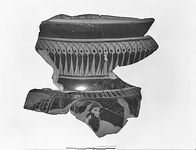Agora Object: Agora XXX, no. 177 | Chronology: | | Ca. 470-460 B.C. | | Deposit: | | D 7:2 | | Published Number: | | AV 30.177 | | References: | | Object: P 7243
|
Four non-joining fragments of neck and shoulder. P.H. a) 0.125; max. dim. b) 0.16, c) 0.11, d) 0.99. E. Laufer, Kaineus: Studien zur Ikonographie [Rivista di archeologia Suppl. 1], Rome 1985, pl. 12:35.
Centauromachy (Kaineus). At the left, fragment b (illustrated) gives the forelock and ear of a centaur to right and on the right, the head, chest, right forearm, and most of the left arm of another, facing to left. He carries a branch in both hands. Between the two, the ends of two plumes that decorate the helmet of Kaineus. Fragment a comes from the other side of the krater (the potting and glaze lines do not match up with those on fragment b). It shows the head and raised left arm of a centaur to left with head turned back and, in the upper left corner of the panel, a branch he carries over his right shoulder. Tongue pattern on the shoulder at the junction with the neck; ivy framing panel; inverted lotus buds with dots in the interstices on neck. Fragments c and d give more of the lotus pattern, and probably one of them belongs above fragment b. Preliminary sketch. Relief contour. Red: leaves of branches.
For the subject of Kaineus, see B. Cohen, "Paragone: Sculpture versus Painting, Kaineus and the Kleophrades Painter," Ancient Greek Art and Iconography, Warren Moon, ed., Madison, Wisc., 1983, pp. 171--192; E. Laufer, Kaineus, passim.
From what remains of the Kaineus scene on Side A of 177, taken together with the curve of the krater's shoulder, it is likely that the composition was a symmetrical one, with the warrior flanked to left and right by a single centaur, similar to the one by the Pig Painter himself, once in the Lucerne Market, now in a Swiss private collection (ARV2 563, 7; Addenda 260).
Earlier Mannerists, i: Manner of the Pig Painter (ARV2 566, 1; Addenda 261).
|
